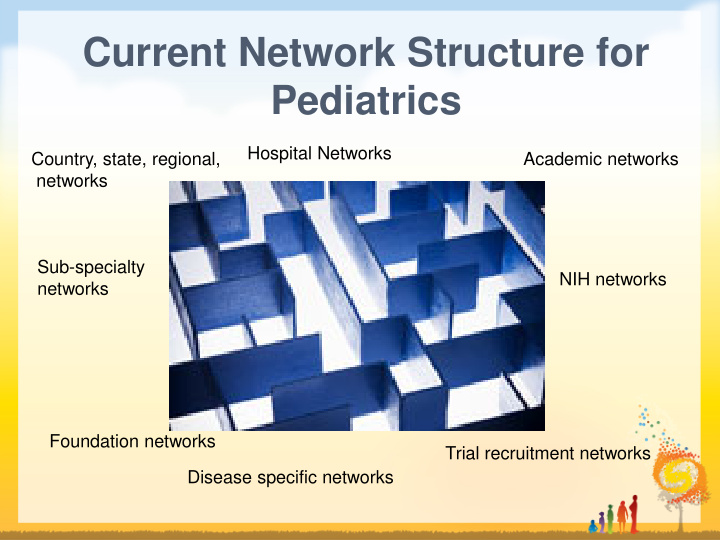



Current Network Structure for Pediatrics Hospital Networks Country, state, regional, Academic networks networks Sub-specialty NIH networks networks Foundation networks Trial recruitment networks Disease specific networks
Networks for Pediatric Drug Development • European network for pediatric research (enpr-EMA): – e.g., PRINTO, PENTA, ITCC, BFM, MCRN, European Research Network in Diabetes and Endocrinology • US: – NIH related networks • Phase 1: Pediatric Trials Network (off-patent) (former PPRU) • Phase 3: CTSA, COG, PHN, neonatal – Association/Foundation networks • CFF, NAPRTCS, AAP PROS, Rare disease – Group or individual sites: • many, fragmented, disorganized, not ready for clinical trials, no incentive for faculty participation – Preferred site program: multiple academic sites and children’s hospitals in US and EU • Global: – PAIDION (newly forming pediatric research organization) – Japan, Canada, Brazil, Argentina, Mexico, Australia
BIO and TransCelerate • “TransCelerate BioPharma will develop shared industry research and development solutions to simplify and accelerate the delivery of innovative products to patients. Our non-profit, procompetitive model will be based on a results-oriented approach, emphasizing increased quality in clinical studies and improved patient safety, enabled by broad participation and collaboration across the global research and development community.” • Made up of 16 BioPharma companies: projects: risk based monitoring, shared site qualification and monitoring, common investigative site portal, clinical data standards – efficacy, comparative drugs for clinical trials. • BIO is committed to improving efficiency of pediatric clinical research • BIO has partnered with ViS Research and is leveraging their analytics platform to better understand the global pediatric research infrastructure • Senior Leadership from TransCelerate has publicly expressed interest in working together to develop and implement a pediatric clinical trial network • BIO is in the very early stages of identifying additional partners and developing timelines for the network http://transceleratebiopharmainc.com, www.bio.org, www.ViSresearch.org
Key Factors for Operational Success • I nnovation in study design – Innovative study designs: extrapolation, pharmacometrics, multi- company studies, adaptive designs, quantitative extrapolation – Registries – Repurposing of existing samples for PK – New technologies for identifying patients and physicians globally • P rotocol(s) – Designed with experts to answer valid scientific questions with feasibility and expedience – Approved by regulatory agencies (global) – Approved by IRB – Developed in conjunction with operational network or CRO • R ecruitment – Based on disease frequency – Countries, sites, investigators, patient population • E nrollment and Retention – Study team
enpr-EMA Processes Internal factors Interactions with industry • Communications are difficult and process • Not transparent to industry for consultation not clear for individual • Structure in itself is an sites nor central administration achievement • Is there a single process or policy or • Added new networks different for each network? • Standard PIPs • Role of individual academicians and sites • Patient group involvement within the networks • Interaction with EMA re: • Role of network in consultation with feasibility EMA? • Confidentiality issues: process and time • Timely consultation • Conflict of interest: EMA vs Industry • Industry is not really a part of enpr-EMA
Enpr-EMA Success • PRINTO, PENTA, ITCC, BFM, MCRN, European Research Network in Diabetes and Endocrinology • Printo (PRCSG) major role in developing and evaluating new therapies for JIA in children • PENTA: HIV • ITCC and BFM for oncology studies; BFM for anticoagulants (COG) • MCRN multiple successes • Diabetes group stimulated recent EMA meeting on T2DM in Feb 2013 that will hopefully allow a redesign of studies to allow for successful completion of these programs where failure was almost certain – Identification of poor enrollment; large numbers of studies and patients required, need for innovative study design
Recommend
More recommend